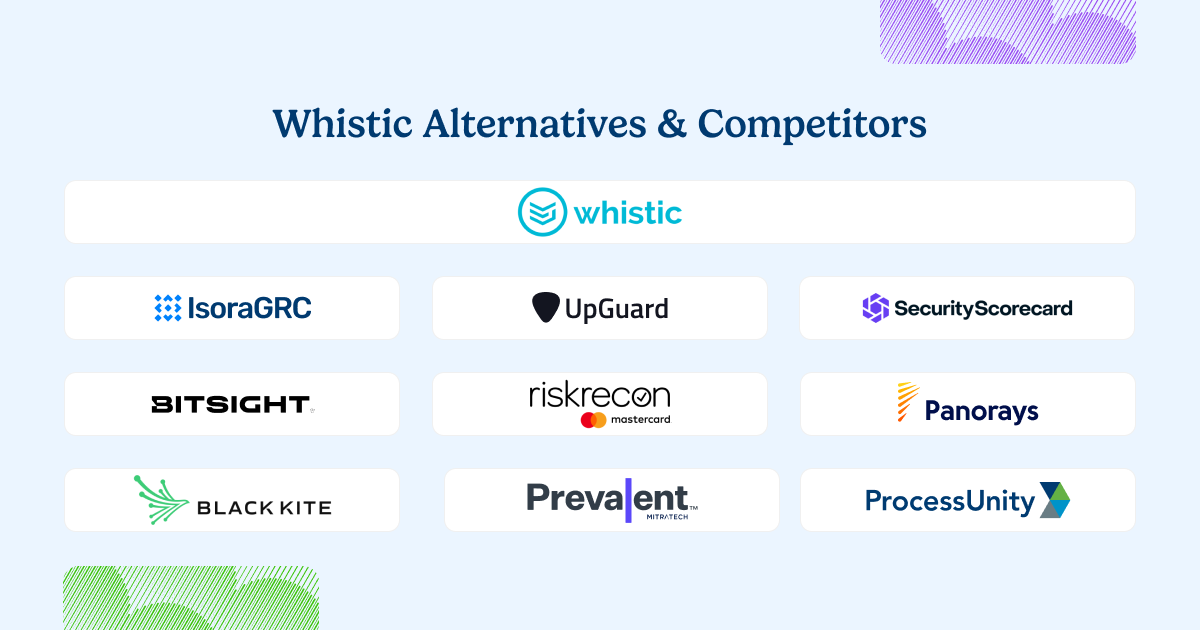
Whistic is designed to streamline the exchange of security questionnaires between companies and vendors. It’s useful for sharing profiles and answering assessments quickly—but it doesn’t offer the workflows needed to manage third-party risk across the full lifecycle.
If your team needs to manage vendor inventories, issue your own assessments, track exceptions, or align third-party risk with internal security strategy, Whistic alone won’t get you there.
Whistic is part of the third-party assessment exchange category—useful for document sharing, but not for managing vendor risk end to end.
Why Teams Look for Whistic Alternatives
| Common Limitation | Why It’s a Problem | What to Look for Instead |
| Built around responding to questionnaires | Doesn’t help you assess or manage vendor risk proactively | Purpose-built for issuing and tracking assessments |
| No structured vendor inventory or risk register | Risk data lives in profiles, not workflows | Centralized inventory with integrated risk tracking |
| Limited exception or remediation workflows | Can’t follow up on identified issues effectively | Built-in exception management tied to assessments |
| Narrow internal use case | Doesn’t support broader IT or internal risk workflows | Platform for managing both internal and external risk |
What to Look for in a Whistic Alternative
- Ability to send and manage vendor assessments across frameworks (SIG, HECVAT, etc.)
- Centralized vendor inventories and issue tracking
- Exception workflows that help teams resolve risk—not just identify it
- Tools that support both third-party and internal security workflows
- Collaboration features that increase visibility and accountability across the organization
Top Whistic Alternatives
1. Isora GRC
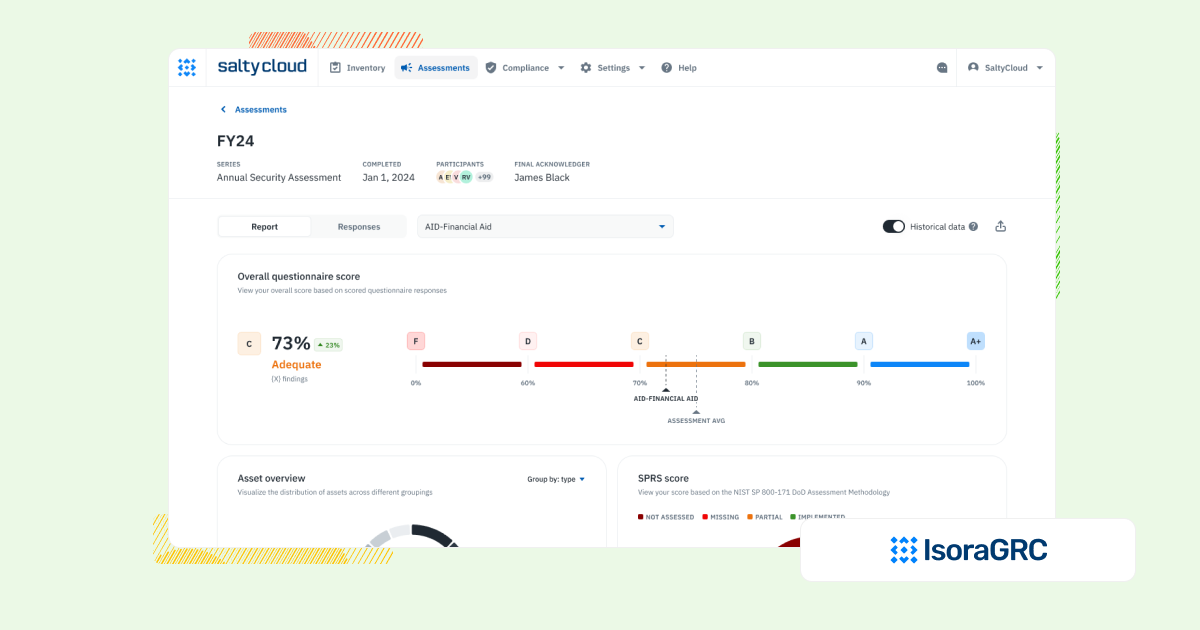
| Category | Details |
| Best For | Security teams that need to operationalize IT and third-party risk management across assets, third-party vendors, and business units. |
| Overview | Isora GRC is the GRC Assessment Platform™ built specifically for information security teams. It supports the full risk workflow, from assessments and questionnaires to risks, inventory, and reporting, without the complexity of legacy GRC tools or the limitations of audit-first platforms. |
| Strengths | Built for workflows, not checklists
✅ Supports assessments, inventory tracking, risk registers, and exceptions in a unified experience. Designed for org-wide adoption ✅ WCAG-compliant UX that requires no training and makes risk everyone’s job. Fast time-to-value ✅ Live in days or weeks, with no-code setup and minimal lift from IT. Flexible by default ✅ Customizable assessments, scalable categories, and framework mapping without heavy configuration. Scales across teams and vendors ✅ Works equally well for internal teams and third-party risk management programs. |
| Limitations | ⚠️ Not designed for legal, audit, or finance teams seeking one platform for enterprise-wide GRC
⚠️ May be too structured for teams looking to build one-off surveys or lightweight audits without repeatable workflows |
| When to Consider | If you need a modern risk platform built for continuous use, with workflows your security team will actually adopt, without the document-sharing limitations of third-party assessment exchange platforms. |
2. UpGuard
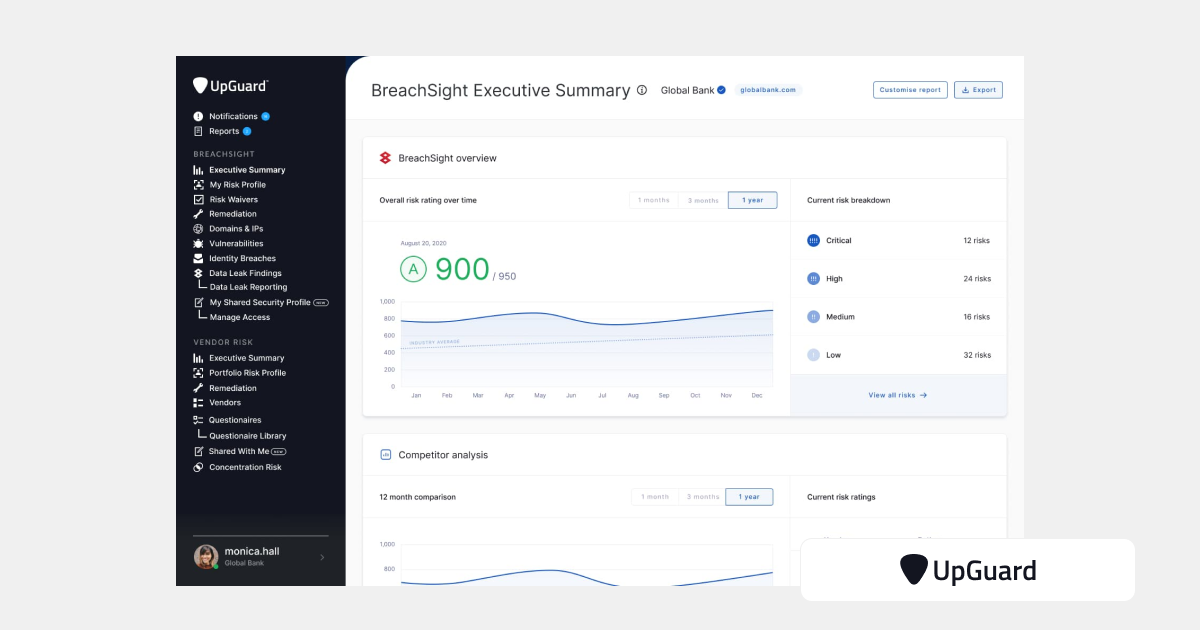
| Category | Details |
| Best For | Security teams that want fast, external views of vendor risk posture. |
| Overview | UpGuard helps monitor vendors using automated scanning and external risk scoring. It’s useful for identifying surface-level risk, but lacks tools for managing vendor inventories, sending assessments, or tracking remediation. |
| Strengths | ✅ External risk visibility through automated scanning
✅ Easy to get started for surface-level monitoring |
| Limitations | ⚠️ No built-in workflows for vendor assessments or internal risk tracking
⚠️ Doesn’t support exception workflows, questionnaires, or remediation |
| When to Consider | If you need basic vendor monitoring but can work around the lack of structured assessments, inventory management, or collaboration features. |
| Other Comparisons | UpGuard vs Vanta vs Isora GRC
Bitsight vs UpGuard vs Isora GRC UpGuard vs Whistic vs Isora GRC |
3. SecurityScorecard
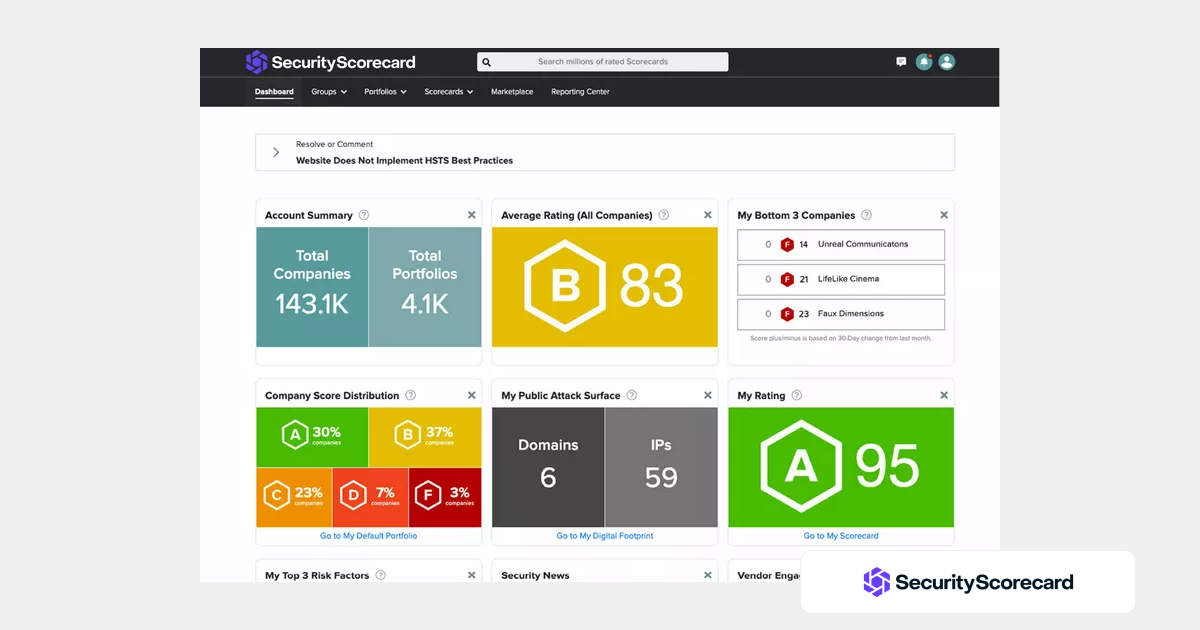
| Category | Details |
| Best For | Organizations that want to continuously track external vendor risk using automated ratings. |
| Overview | SecurityScorecard monitors vendors using public and behavioral data to generate risk scores. It’s great for spotting third-party risk trends, but doesn’t help with issuing assessments or managing internal follow-up. |
| Strengths | ✅ Real-time vendor scoring with broad coverage
✅ Integrates easily into procurement workflows |
| Limitations | ⚠️ Lacks tools for sending questionnaires or tracking exceptions
⚠️ No vendor inventory or risk ownership features |
| When to Consider | If you need fast external scores but can work around the lack of structured third-party assessment tools and internal issue tracking. |
| Other Comparisons | Bitsight vs SecurityScorecard vs Isora GRC
RiskRecon vs SecurityScorecard vs Isora GRC |
4. Bitsight
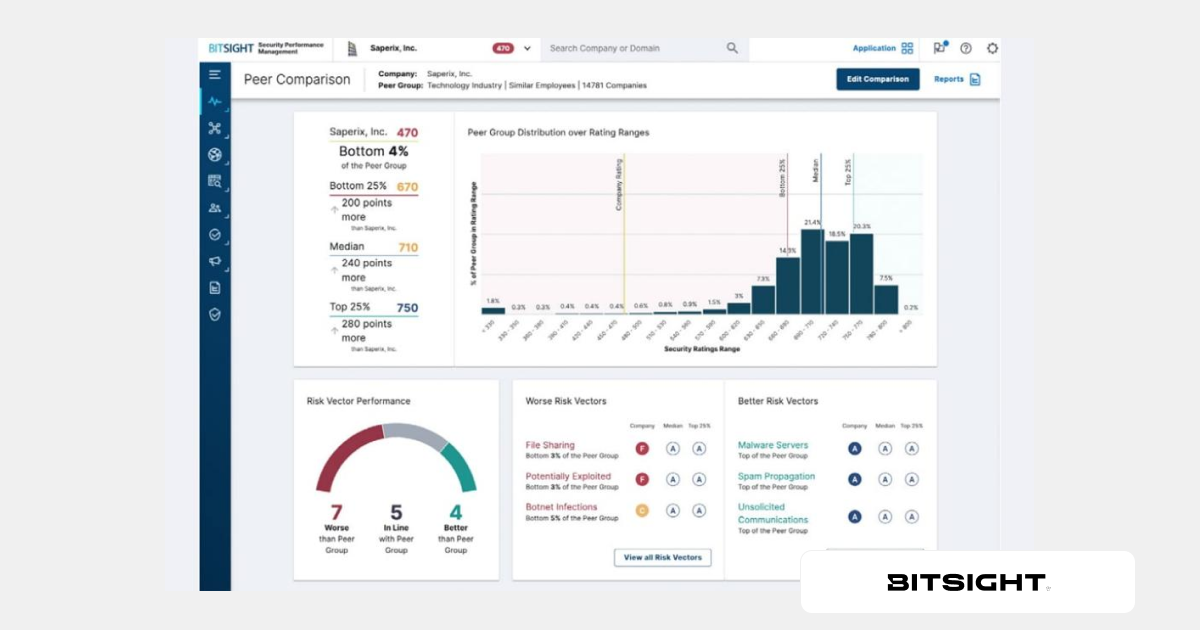
| Category | Details |
| Best For | Teams that want to evaluate vendors based on external cybersecurity posture and score comparisons. |
| Overview | Bitsight provides external security ratings and benchmarks vendor posture across risk categories. It’s good for surface-level monitoring, but not built for internal assessment workflows or exception resolution. |
| Strengths | ✅ Clear, standardized security ratings across thousands of vendors
✅ Easy to incorporate into risk reporting and procurement processes |
| Limitations | ⚠️ Doesn’t support questionnaire workflows, remediation, or inventories
⚠️ Risk scores aren’t tied to internal follow-up or decision-making |
| When to Consider | If you want to quickly compare vendors at a high level but can work around the lack of hands-on risk assessment or vendor engagement tools. |
| Other Comparisons | Bitsight vs UpGuard vs Isora GRC
Bitsight vs SecurityScorecard vs Isora GRC |
5. RiskRecon
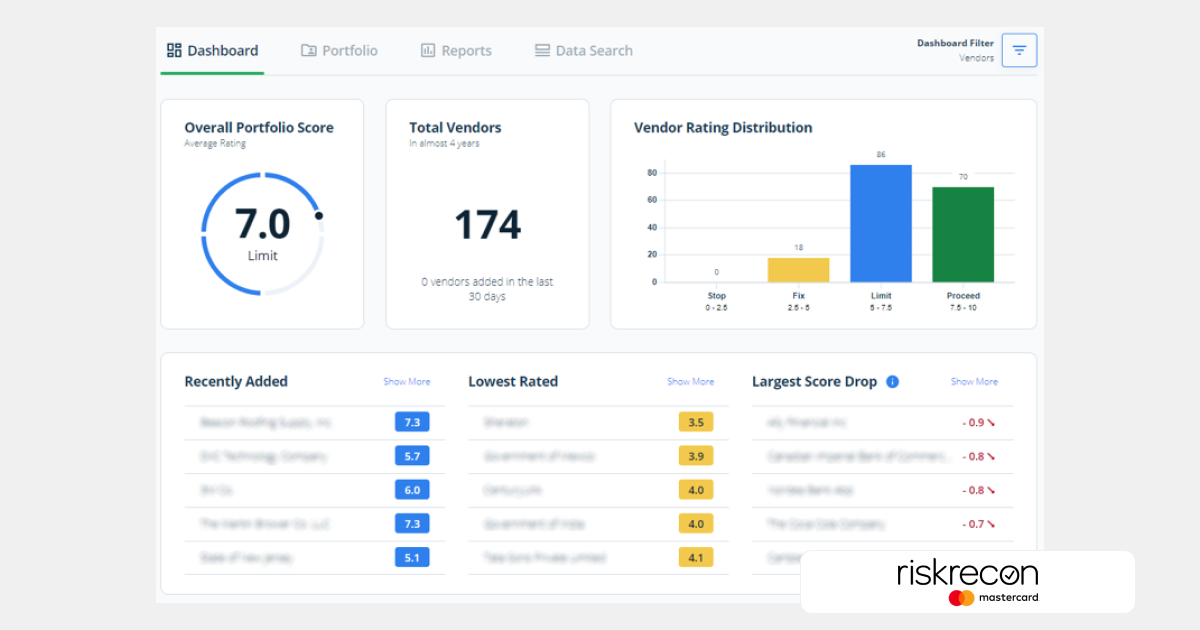
| Category | Details |
| Best For | Security teams that need quick external snapshots of vendor risk, not ongoing assessment management. |
| Overview | RiskRecon uses public data to provide vendor cyber risk scores and issue alerts. It’s useful for monitoring changes in external posture but doesn’t support workflows like questionnaires, issue tracking, or remediation management. |
| Strengths | ✅ Continuous vendor scoring with risk prioritization
✅ Simple and visual risk summaries |
| Limitations | ⚠️ Doesn’t support assessment issuance, internal workflows, or exception management
⚠️ Limited ability to act on or resolve identified risk |
| When to Consider | If you want external visibility into vendor risk posture but can work around the lack of tools to manage assessments, remediation, and collaboration internally. |
| Other Comparisons | RiskRecon vs SecurityScorecard vs Isora GRC |
6. Panorays
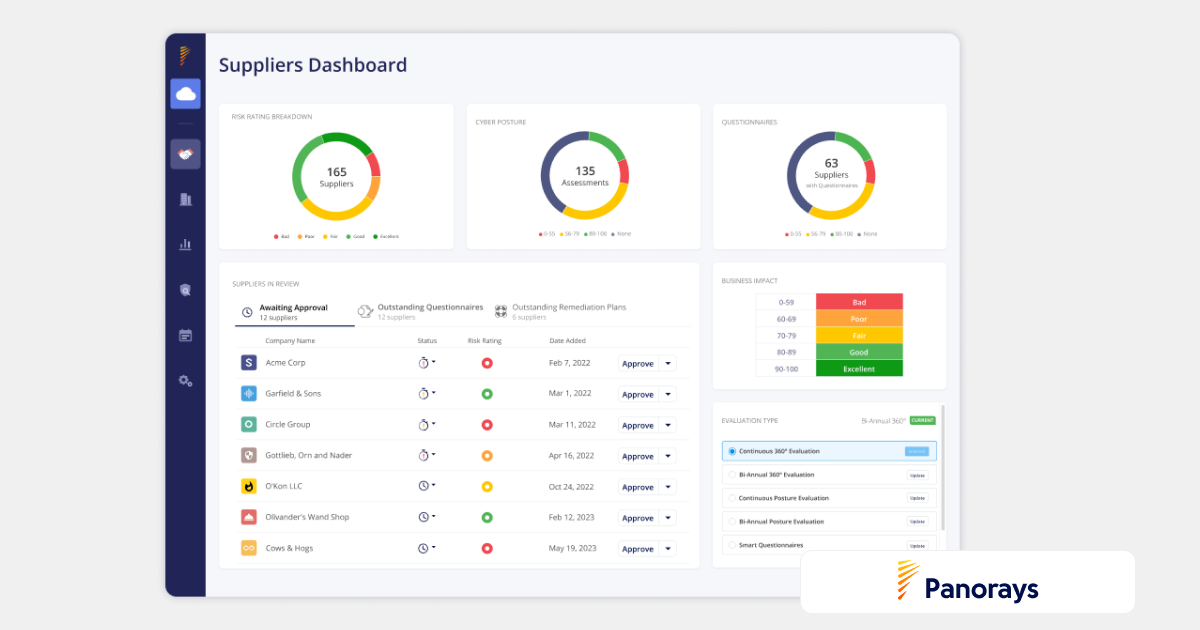
| Category | Details |
| Best For | Organizations that want to pair external vendor scores with basic questionnaire capabilities. |
| Overview | Panorays combines external vendor risk monitoring with lightweight survey tools. It helps teams onboard vendors and check surface-level security posture, but lacks robust workflows for exception management or full lifecycle risk tracking. |
| Strengths | ✅ Merges ratings with built-in assessment questionnaires
✅ Speeds up vendor onboarding and initial reviews |
| Limitations | ⚠️ Lacks deeper workflows for remediation or exception tracking
⚠️ No centralized risk register or vendor inventory management |
| When to Consider | If you want to combine scores with surveys but can work around the absence of structured risk tracking and remediation features. |
| Other Comparisons | Bitsight vs Panorays vs Isora GRC |
7. Black Kite
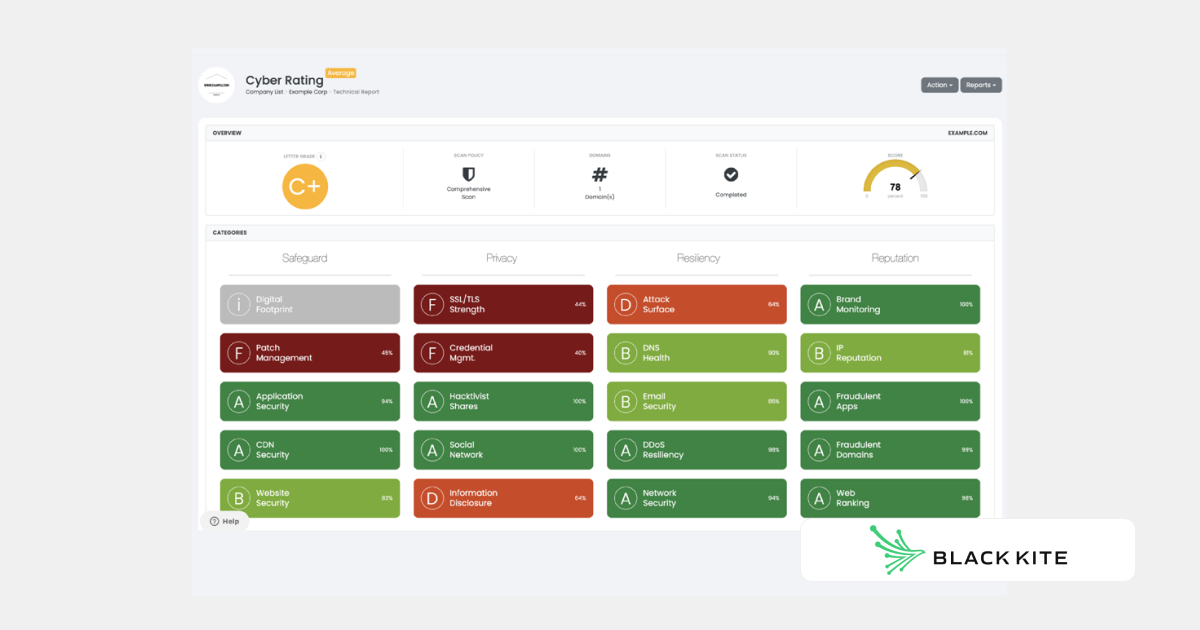
| Category | Details |
| Best For | Teams that want to translate vendor cyber risk into business impact terms like financial or regulatory exposure. |
| Overview | Black Kite gives vendors external security ratings and estimates potential questionnaires, track exceptions, or manage vendor inventories. |
| Strengths | ✅ Business-focused vendor risk scoring
✅ Includes financial, operational, and regulatory exposure metrics |
| Limitations | ⚠️ Doesn’t support internal assessments, inventories, or issue resolution
⚠️ Limited support for collaborative workflows across teams |
| When to Consider | If you want to show vendor risk in business terms but can work around the lack of tools for assessing, tracking, and remediating vendor risk internally. |
| Other Comparisons | Black Kite vs Bitsight vs Isora GRC |
8. Prevalent
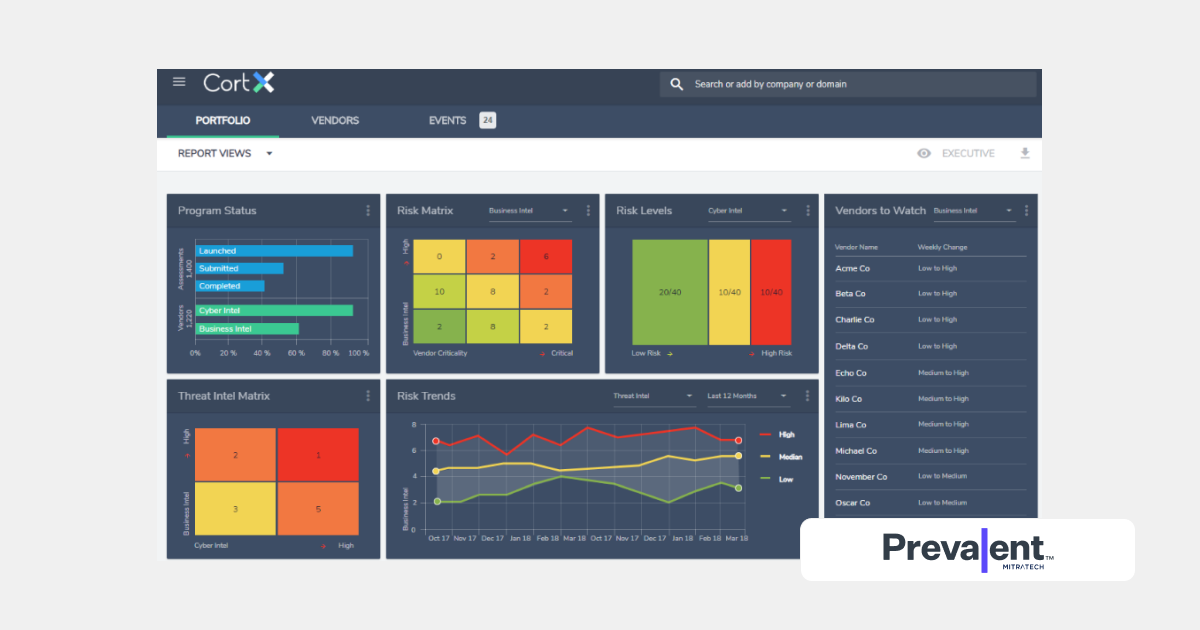
| Category | Details |
| Best For | Organizations that want to issue assessments, collect evidence, and monitor vendor risk all in one place. |
| Overview | Prevalent is a full-featured vendor risk management platform that combines assessments, continuous monitoring, and exception tracking. It goes beyond surface-level scoring and supports deeper workflows, though it may require time to configure. |
| Strengths | ✅ Issues vendor questionnaires and tracks remediation
✅ Includes pre-built templates (SIG, CAIQ) and external threat data |
| Limitations | ⚠️ Requires some setup and training to align with internal needs
⚠️ Focused on vendor risk, not broader internal risk workflows |
| When to Consider | If you want a complete TPRM platform with integrated monitoring and assessments but can work around limited support for internal IT risk management. |
9. ProcessUnity
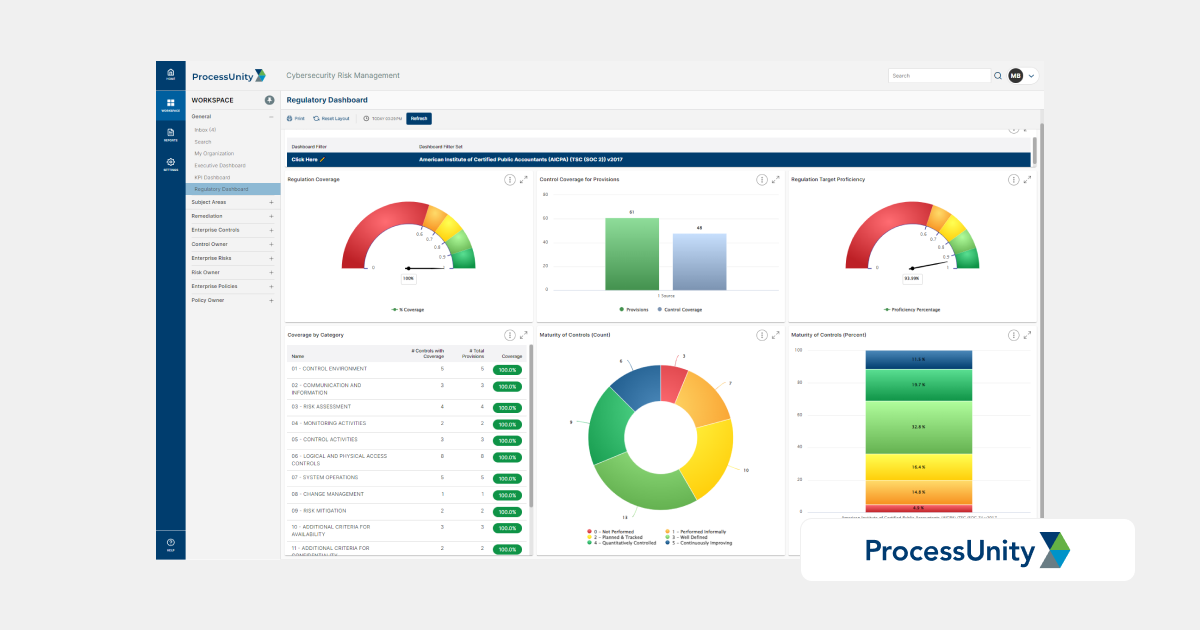
| Category | Details |
| Best For | Security and risk teams looking to centralize and automate vendor risk across the full lifecycle. |
| Overview | ProcessUnity helps organizations manage onboarding, due diligence, assessments, and ongoing monitoring in one platform. It’s structured and scalable but may require configuration to fit internal team workflows. |
| Strengths | ✅ Supports vendor assessments, inventories, and remediation tracking
✅ Scalable for mature TPRM programs with custom workflows |
| Limitations | ⚠️ Setup and configuration can take time
⚠️ Not designed to manage broader internal security or IT risk workflows |
| When to Consider | If your team needs a robust platform to manage third-party risk end to end but can manage internal risk tracking elsewhere. |
| Other Comparisons | ProcessUnity vs Allgress vs Isora GRC |
What Our Customers Say About Isora GRC
Security teams at top institutions are using Isora GRC to replace legacy tools and manual processes with intuitive workflows and actionable insight.
“Moving from manual processes to using Isora was a breath of fresh air. What used to take months is now automated, reliable, and defensible. Isora saves us significant time while delivering accurate insights that improve decision-making.”
Jessica Sandy, IT GRC Manager, The University of Chicago
“Isora has been essential in helping us meet our University of California cybersecurity requirements across a decentralized campus. Automating assessment data collection and reporting has given us clear visibility into unit-level risks, enabling us to prioritize resources effectively and address gaps with confidence.”
Allison Henry, CISO, The University of California, Berkeley
FAQs
What are some alternatives to Whistic?
Whistic is a third-party risk tool focused on exchanging security questionnaires and sharing vendor profiles. Alternatives like Isora GRC support the full vendor risk lifecycle—enabling security teams to send assessments, collect responses, track exceptions, and maintain centralized vendor inventories.
Why do teams switch from Whistic to platforms like Isora GRC?
While Whistic is helpful for responding to questionnaires and sharing profiles, it doesn’t offer structured workflows for managing vendor risk internally. Teams often move to Isora GRC when they need better control over assessment delivery, risk tracking, and remediation follow-up.
Does Isora GRC replace tools like Whistic or complement them?
Isora GRC typically replaces Whistic for teams that want to manage third-party risk more proactively. Isora enables you to issue assessments, maintain vendor records, log exceptions, and collaborate with internal stakeholders—all in one platform.
Which platform is better for tracking vendor risk across the organization?
Whistic is useful for profile sharing, but it doesn’t support inventory management or internal collaboration. Isora GRC is purpose-built to engage teams across security, legal, and procurement—helping organizations manage vendor risk with clarity and structure.
What should I look for in a Whistic alternative?
Look for tools that go beyond questionnaire exchange. A strong alternative should let you assess vendors directly, track risks and exceptions, maintain an inventory, and collaborate across teams. Isora GRC delivers all of that in one streamlined platform.
This content is for informational purposes only and does not constitute legal or compliance advice. See our full disclaimer.


















